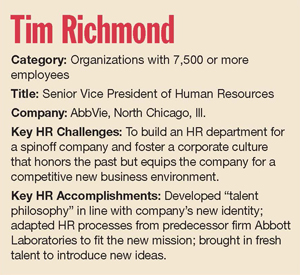This article accompanies Back on Track.
Most chief HR officers inherit the job, taking charge of an operation that already has a deep history. Some get to create an HR department from scratch at a start-up.
Tim Richmond got to do both – at the same time.
When Abbott Laboratories spun off AbbVie in 2013, Richmond moved from the first company to the second as its first senior vice president of human resources. His challenge included managing the transition for thousands of employees at Abbott, where he had been vice president for compensation and benefits.
But he also had an even tougher job: to foster a corporate culture suited to AbbVie’s new mission and identity. Building an HR operation that recognized both old and new is what earns Richmond his place on the 2016 HR Honor Roll.
Richmond is keenly aware of the need to balance tradition with innovation. Abbott is a 128-year-old company with a wide range of products including generic drugs, diagnostic systems, medical devices and nutritional aids. AbbVie is a brand-new biopharmaceutical firm sharply focused on developing new drugs. It competes with established pharma giants and nimble young start-ups.
“So we wanted to be both of those things,” Richmond says. “That was a key attribute for us.”
Richmond, 50, is a native of Minneapolis who earned his bachelor’s degree from the University of Minnesota and a master’s degree in labor and industrial relations from Michigan State University. He spent 14 years at the 3M Co., moving up through a series of posts in the United States and abroad to become the company’s global director of talent management.
In 2006, Richmond left 3M to join Abbott in Lake Bluff, Ill. Seven years later, he took his current job at AbbVie’s headquarters in nearby North Chicago. He and his wife live with their three children in Lake Forest, Ill.
Richmond credits AbbVie chairman and CEO Richard A. Gonzalez with setting the tone early on and leading the executive team in formative discussions about the new company’s identity. A key result was “Ways We Work,” a document spelling out high-level principles to guide everyone at the company. Those principles include being “agile and accountable,” using communications that are “clear and courageous” and sharing a company goal to “make possibilities real.”
That initial discussion “created a stronger executive-leadership team,” with all the new top leaders buying into the principles, Richmond said. “We were able to say we want all of these things – this is our level of expectation.”
From that flowed the new company’s “talent philosophy.” It includes setting elevated expectations for performance, accountability and transparency. It also holds that “how you do your work and lead is as important as your work” itself, Richmond says. “It was really important to say that.” That philosophy is built into the company’s new development and performance-appraisal processes.
Blending the old and new has shaped everything Richmond has done at the new company. That includes setting the tone for hiring; the company deliberately sought to bring in fresh talent and ideas. AbbVie now has more than 28,000 employees at offices, research centers and manufacturing sites across the United States, Europe and Asia.
“We benefit from a nice mix of people who understand our heritage [at Abbott], but also people who just understand AbbVie and want us to be the best company we can be,” Richmond says. Because of new hires and acquisitions, nearly 40 percent of workers now have never worked at Abbott.
To help the new company move as swiftly as its nimble competitors, Richmond and his colleagues found ways to tailor inherited HR processes. One example: combining the merit-raise, annual incentive and long-term incentive awards, previously separate processes performed on separate schedules, into a single process.
This move “really simplified the process for leaders – and also enhanced the message to the employees” about what the company was rewarding through compensation, he says.
Employees are getting the message, and internal surveys show record – and rising – levels of engagement, Richmond says. “No one’s declaring victory – but we’re really confident we’re doing a lot of the right things,” he says.
It all seems to be working for the bottom line as well. AbbVie has been profitable since its first year, and earned $5.1 billion on revenue of $22.9 billion in 2015. Its share price has risen 86 percent since the company launched through the end of July, outpacing both the Dow Jones Industrial Average and its predecessor, Abbott Laboratories.
 Richmond sees business success as the ultimate measure of a strong corporate culture.
Richmond sees business success as the ultimate measure of a strong corporate culture.
“You can have the best slogans in the world, you can do all the work of aligning these things we talk about,” he says. “But if you’re not getting some level of positive return on people’s efforts and commitment in business success, then you’re just not getting there.”
And he sees some lessons there that his profession could benefit from.
“I think sometimes HR people get wrapped around the axle on some of the administrative things. I see people wringing their hands over performance-management concepts and generational gaps in the workforce. I think, ‘Let’s stay focused on driving business performance,’ “ Richmond says. “When we do that, we’re at our best.”

